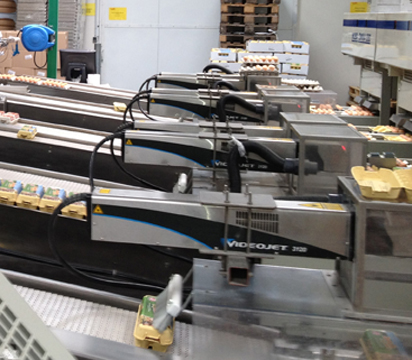New EU Standards for Egg Coding – What Changes from November 8, 2024?
Egg coding is mandatorily regulated throughout the EU. The European Union has now further increased these standards for transparency and safety within the food industry with the introduction of the new egg labeling regulation*. The amendment, which comes into effect from November 8, 2024, aims to improve traceability and prevent mislabeling by clearly defining the location of egg marking.
What changes with the new regulation?
Until now, the coding of eggs could take place either directly at the production site or at the first packing center to which the eggs are delivered. This led to problems with traceability in practice, as well as to incorrect coding, since eggs from different farms and different production systems could be mixed and mislabeled. To ensure the integrity of the supply chain, the EU now requires that labeling must mandatorily take place at the origin of the eggs, that is, on the farm of the producer. Exceptions are only allowed under strict conditions to avoid jeopardizing traceability.
For optimal traceability of eggs, a complete code is applied to each shell. At any time, this labeling enables the tracking of the egg’s journey.
- The first digit allows the consumer to recognize the type of hen rearing system.
- The following two letters allow identifying the country of laying: IE stands for Ireland.
- After that, a code allows identifying the origin farm.
While the first two pieces of information also serve consumer information, the farm number is information for the competent control authorities.
What coding should be on the egg packaging?
The boxes are there to protect the eggs from shocks, odors, light. The marking must be placed on the outside of the packaging in clearly visible and easily readable print. The following mandatory information must be indicated on the egg cartons to immediately identify the key information:
- The recommended consumption date (DCR).
- Information on rearing: the country of origin, the producer code, and the method of rearing.
- The number of the packing center.
- The size of the egg (S, M, L, XL)
- The rearing method.
- The category “fresh” symbolized by the letter A for eggs sold to consumers.
What is the best way to code on eggs?
In this new regulatory context, the Videojet 1620 FG Food Grade printer comes into play. This Continuous Inkjet (CIJ) printer not only meets the requirements for food safety but also offers a range of advantages that make it the perfect choice for egg producers:
- Food-grade ink: The use of ink that complies with strict EU regulations is essential. The Videojet 1620 FG uses ink that is safe for use on food, thus posing no health risks.
- High printing speed and quality: In the fast-paced world of food production, efficiency is key. This printer offers high printing speed without compromising on quality, ensuring a smooth production and packaging process.
- Robustness and reliability: The Videojet 1620 FG is built for the harsh environment of food production. Its durability ensures that producers can rely on continuous operational readiness.
- User-friendliness: With an intuitive user interface and simple maintenance processes, the Videojet 1620 FG is easy to operate and maintain, saving time and resources.
- Adaptability: The printer can be adapted to different production lines and speeds, making it a flexible solution for operations of any size.
*Commission Delegated Regulation (EU) 2023/2464 of 17 August 2023 amending Regulation (EU) No. 1308/2013 of the European Parliament and of the Council with regard to marketing standards for eggs.
Contact Us
Equipment Sales:
01267 6687
Service & Support:
+353 1 267 6503 (Republic of Ireland)
03301233930 (Northern Ireland)




